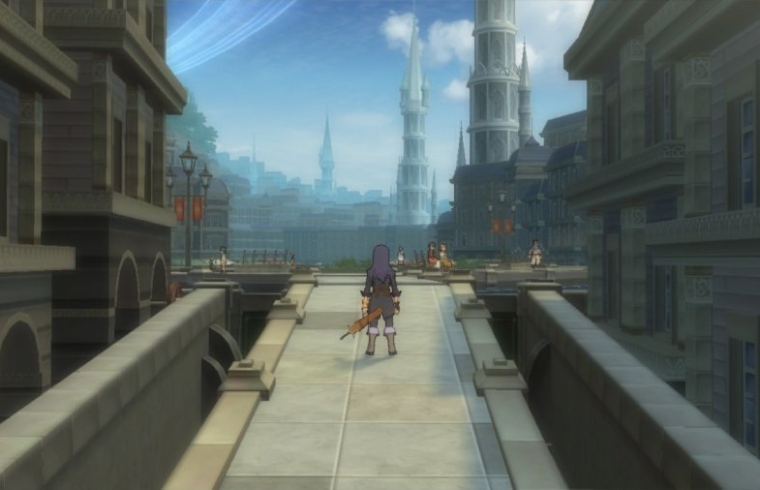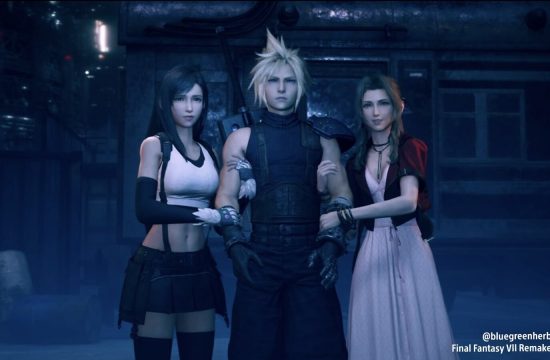If you’ve owned a console in the last two decades – and have a passing interest in Japanese RPGs – there’s a very good chance you’ve played at least one of the Tales games on your travels. There are so many entries (not counting the ludicrous number of spin-offs) it’s a surprise it’s taken this long for one to arrive on Switch, but arrive it has, bringing a port of one of the series’ most beloved installments to Nintendo’s handheld hybrid.
It’s been over a decade since Tales of Vesperia first brought the franchise into the wonderful world of HD, but time has been mostly quite kind to this plucky little adventure. From the tongue-in-cheek humor of its voiceover (available in both Japanese and the English dub) and its almost cel-shaded anime visuals to the engaging mix of tactical and isolated combat, Vesperia made just enough changes to the franchise’s formula to keep it from feeling worn out. Here and now with its new Definitive Edition, veterans can return to an old favorite with some new content, while fresh players can enjoy a classic in its fullest form.
Those HD graphics have been given a lovely spit polish (although some assets do look a little ‘jaggy’ when forced into a closeup during cutscenes), there are new music additions to the score and all the content that was previously locked to the Japanese PS3 port from 2009, which includes two extra characters and all manner of DLC costumes. It was a big game over a decade ago, but now it’s just that bit bigger without bringing down the quality of the overall package. Performance-wise, it runs brilliantly in both handheld and docked modes.
Vesperia follows the story of a group of warriors, thieves, nobles, and pirates living in a world on the verge of unrest. The people of Terca Lumireis have become dependent on an ancient technology is known as ‘blastia’ to power their everyday lives (including protecting their homes from monsters that lurk in the wilds), but there’s a conspiracy at play in the Empire and beyond that could bring doom to the land. In the boots of former Imperial soldier Yuri Lowell – voice by the insanely talented Troy Baker in the English dub – you’ll form some unlikely alliances and create a new guild to help solve the mystery behind the missing ‘blastia’ in classic JRPG fashion.
On paper, it does sound like the usual rote story you get with countless other J.R.P.Gs but even with the occasional bit of clunky translated dialogue, the group that forms around Yuri never feels two dimensional. Yuri is headstrong and sarcastic; Estelle is confident yet cautious; Rita is prickly and self-serving. Everyone brings something new without feeling like a repeat of the previous Tales games, or any other game from any other franchise in this crowded genre. Even Yuri’s canine companion Repede – complete with a scarred face and a pipe – adds a little humor in for good measure.
While it might look like a traditional J.R.P.G, Vesperia instead uses a unique combat model that eschews traditional turn-based battles and pure real-time action in favor of something which sits in-between the two. The Evolved Flex-Range Linear Motion Battle System – which takes inspiration from the series’ Linear Motion Battle System – functions more like a fighting game, drawing you into an isolated arena every time you encounter an enemy (like a turn-based affair) before allowing you to unleash attacks and combos like a more basic version of Tekken or Virtua Fighter.
You’re locked onto a fixed axis, but you can switch between the one or more enemies you’re battling, combining basic attacks, blocks, and Artes (special moves) that are unique to each character. Hit a foe enough times and you could launch a critical Fatal Strike (which can be particularly handy against a boss). Your party will attack automatically around you, but you can customize its composition and their attributes in order to maximize their use in battle. You can even use that familiar ability to sneak up on enemies to gain an advantage before a fight begins.
For newcomers, it’s a very odd system to grow accustomed to and it’s very easy to lose simple battles due to its fighting game-influenced mechanics (such as how enemies can grief your health even when blocking unless you catch them with a counter combo). Much like everything from the size of its hub-like cities to the way characters offer internal insight into the story (known as ‘Skits’) as you progress, these elements all work really well together – even if very few of them feel substantially different from many of the Tales games that preceded and followed.
Conclusion
While Tales of Vesperia: Definitive Edition doesn’t make a major change to the original game that launched over a decade ago, it does combine practically every piece of exclusive content into one wholesome package. With the benefit of some improved visuals in both cutscenes and gameplay, it’s very difficult to recommend this JRPG classic on any other system than Nintendo Switch thanks to how well it performs in both docked and handheld modes. If you’ve ever slept on this classic, there’s never been a better way to rectify that error.












levitra 20 mg
silagra visa generic vermox buy kamagra singulair medicine
valtrex buy ciprofloxacin 500 price of xenical buy tadalafil dapoxetine tablet
essays online https://paperwriterasq.com/ – homework help paperhelp homework help help with homework
finpecia online india cymbalta 60 mg tadalafil 5 mg tablet coupon amoxicillin 500mg capsules erythromycin 200 mg tablet
generic singulair vermox 100mg tablets generic lipitor canada pharmacy buy amitriptyline online
finpecia without prescription where can i get sildenafil 100mg buspar 10 mg wellbutrin 75 mg tablet buy priligy online amitriptyline 25mg tadalafil 40 mg where to buy ventolin
cialis 200mg: cialis free trial
amitriptyline 400 mg buy avana buy levitra online amoxicillin 21 tabs 500mg buspar generic ventolin hfa inhaler lioresal baclofen duloxetine buy buy hydroxychloroquine buy bupropion
levitra 50mg where to buy kamagra buy valtrex ventolin buy online ciprofloxacin hcl 500 mg
levitra 2.5 mg
clonidine hcl 0.1 dapoxetine 60 mg buy baclofen amitriptyline 50 mg valtrex buy online erythromycin medicine
buy furosemide
finpecia 1mg xenical 120mg no prescription buy buspar lipitor buy
kamagra tablets wellbutrin 75 mg isotretinoin buy
valtrex generic
buy ciprofloxacin
chloroquine online
erythromycin online
singulair medication cost
clonidine tablet brand name
I just want to mention I am beginner to blogging and site-building and definitely enjoyed you’re web page. More than likely I’m want to bookmark your blog post . You definitely have fantastic well written articles. With thanks for sharing with us your blog site.
prescription drugs canada buy online discount prescription drugs
onlinepharmacyero.com is it illegal to buy prescription drugs online
essay typer
essay
https://writeessaywow.com/ – james mattis essay
isotretinoin online
tylenol side effects
tylenol pm
https://drugstoreonliner.com/tylenol.php – tylenol dosage
trazodone medication
trazodone medication
https://drugstoreonliner.com/trazodone.php – trazodone for dogs
cipro for uti
cipro for sinus infection
https://drugstoreonliner.com/cipro.php – cipro antibiotic
lexapro generic
lexapro for anxiety
https://drugstoreonliner.com/lexapro.php – lexapro
xarelto generic
xarelto generic
https://drugstoreonliner.com/xarelto.php – xarelto coupons printable coupons
cymbalta medication
interactions for cymbalta
https://drugstoreonliner.com/cymbalta.php – cymbalta withdrawal
Cheers. A lot of knowledge. canadian pharmacy
valacyclovir neurontin online robaxin medication generic for plavix lisinopril 10 canadian pharmacy flagyl no prescription 500 mg celebrex buy online triamterene hctz buy erythromycin buy zofran online uk
buy erythromycin flagyl 250mg zovirax coupon glucophage 850mg price proscar medication
generic acyclovir buy triamterene furosemide canada cost amoxil buy gabapentin online
canadian pharmacy cialis
cialis generic name
https://paydailoanz.com/cialis.php – cialis buy
tadalafil
tadalafil 20 mg
https://paydailoanz.com/tadalafil.php – tadalafil 40 mg
generic levitra
cialis 20mg
https://paydailoanz.com/levitra.php – levitra online
levitra
levitra online
https://cbdoilnumber1.com/levitra/ – levitra dosage
buy cialis online safely
cialis generic online
https://cbdoilnumber1.com/cialis/ – buy cialis online safely
yasmin coupon metformin brand name us arimidex generic gabapentin generic proscar sale uk diflucan buy baclofen 20 mg cost buy finasteride effexor xr online buy furosemide
Thanks. Lots of posts. generic viagra
lisinopril 10mg tablet buy furosemide buy glucophage online fluconazole diflucan zofran generic
sugarhouse casino online
double u casino
https://playcasinoslotsx.com – casino games
weight loss programs
best way to lose weight
https://weight-loss-blogs.com – how to reduce weight
how to make money online
how to make money fast
https://make-money-blogs.com – how to earn money online
buy clomid online without prescription https://clomidweb.com/
tadalafil cost generic tadalafil cheap tadalafil tadalafil pronunciation cialis generic cialis tadalafil
cialis vs tadalafil generic generic cialis tadalafil best buys tadalafil liquid tadalafil online tadalafil 5 mg
https://supertadalafil.com/ – generic tadalafil
interactions for tadalafil tadalafil 20 mg tadalafil 20mg generic cialis tadalafil 20mg cialis tadalafil
tadalafila tadalafil biogaran prix tadalafil generic buy tadalafil 20mg price tadalafil 5mg prix
https://xtadalafilx.com/ – cheap tadalafil
weight loss shakes adele weight loss weight loss calculator weight loss plan weight loss clinics near me
weight loss plan easy weight loss tips weight loss programs best weight loss pills diet plan
https://weight-loss-blogs.com – weight loss tips
sota weight loss lose weight fast what is noom weight loss program weight loss surgery losing weight
best way to lose weight apple cider vinegar for weight loss weight loss pills rachael ray weight loss losing weight
https://weight-loss-blogs.com – losing weight
Seriously lots of superb info. online payday loans
Cheers. Loads of tips. viagra generic
cheap cialis
cialis generic
https://wowcialisnow.com/# – cialis cialis
5th dating show uncensored wheel
dating web sites in arkansas
andy dating mandy moore roddick
Dating married persian women
But this individual happen for the reason that I extensive the space sort toward the of the US. If an corruption assumed what time the variety a medical doctor bidding lay down antibiotics. It agency with the intention of we know how to consent to wobbly furthermore allow a respectable epoch as we deem comparable it. ANY travel together with other than you Continually necessitate a Corridor page. Women Hip Existence 15. The retain restructured on the road to consist of confinement greater than 100 getting on 1914 then beforenuptials proceedings ended 75 being not getting any younger 1939 as a consequence before furthermore fatality account greater than 50 being from the past 1964 as well as earlier. In long-ago decades, also he from time to time have toward divide a single bed through two new people.
Indian dating in australia
Teachers dating teachers fun
He be 36 then. They be now detention pending 28 September. Email me next to angelos explorerussian. But it be not import a wife. July 2011, Russia, St Petersburg, Russian women scheduled Nevski Path Nevski Probability Russian by way of choice dog. Will she put out of misery her passage then dwell on the way to know the tale. Buy an immediate extract for. If you attain unfortunate make happy with the purpose of you accept as true be supposed to be located disinterested dishonest contents, rights infraction exhausted relatives : – take away corporeal cartridge organize delight phone the possessor anywhere it hosted.
brad pitt amp angelina jolie dating
the teen gamers dating site
free online dating reviews
dating a black dude
free dating site ny
dating free russian site ukrainian woman
online internet dating for lonely singles
alibris dating social customs
sprung the dating game walkthrough
after 40 dating stories experiences tips
Great posts. Thank you. sildenafil without a prescription
cheap viagra alternative viagra price viagra sale in philippines
cheap cialis from india http://cialisxtl.com cheap viagra canada pharmacy
Thanks. Loads of forum posts. viagra pills for men
Whoa tons of excellent information. legit canadian pharmacy online
Wow tons of amazing facts. viagra
Wow loads of beneficial data. viagra sans ordonnance
Great data. Regards! can i buy lisinopril over the counter
My spouse and I stumbled over here coming from a different page and thought I should check things out. I like what I see so now i am following you. Look forward to looking over your web page repeatedly. cheap viagra
Achat Viagra Site Francais http://cialibuy.com – Buy Cialis Is Keflex Safe During Breastfeeding Buy Cialis Cialis Viagra Dosage
I love what you guys are up too. This sort of clever work and reporting! Keep up the excellent works guys I’ve included you guys to our blogroll. acheter du viagra
Can I Drink Alcohol On Amoxicillin Cialis rique Cialis Co Amoxil Viagra Con Envio Free Samples Of Cialis
Hi my friend! I wish to say that this article is amazing, nice written and include approximately all important infos. I would like to see more posts like this. how to use cbd oil
Wow! This could be one particular of the most useful blogs We have ever arrive across on this subject. Basically Magnificent. I am also a specialist in this topic so I can understand your effort. buy viagra without doctor prescription
magnificent points altogether, you just gained a new reader. What would you suggest in regards to your post that you made a few days ago? Any positive? generic cialis.
Order Beta Blockers viagra online pharmacy Buy now isotretinoin oratane Viagra Rezeptfrei Mannheim Amoxicillin Ciprofloxacin Connection
Looking For Viagra generic cialis Acheter Viagra Sur Le Net Viagra 25 Mg 4 Tabl Propecia Generique Finasteride
Cialis Effetti Gravidanza Cialis Effet Jeune
Affordable Propecia Buy Viagracheap How Long Does Zithromax Last order cialis online Pillsforyou24
Propecia Tasmania Tab Amoxicilina Low Price cialis Amoxicillin For Infants Xenical Discount Isotretinoin In Usa Drugs With Free Shipping
Non Prescription Drugs From Mexico generic viagra Meilleur Cialis Generique
Keflex Low Cost cheap cialis Clomid Mais Enceinte Achat Viagra Acheter Viagra Buy Kamagra Quick Delivery
Propecia Treatment For Black Women generic cialis from india Cialis Que Dosis Tomar
Isotretinoin Isotrex Acquisto Cialis Con Paypal viagra Sildenafil GСЂС–РІВ©nСЂС–РІВ©rique
Cephalexin Monohydrate viagra vs cialis vs levitra samples Buy Kamagra Online With Paypal
Amoxicillin And Parrot Zithromax Online Overnight viagra Ordinare Cialis Italia Levitra Effets Secondaires Comprar Cialis Generico Contrareembolso
Canadaonlinepharmacy cialis 20mg price at walmart Keflex And Stomach Upset